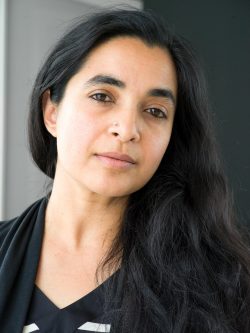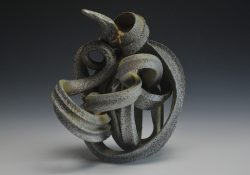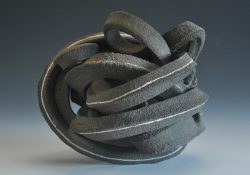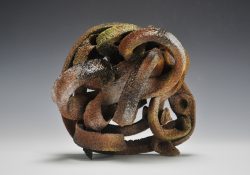Ashwini Bhat, a ceramic artist based in Petaluma, California, traveled into and away from communities of potters on several continents before she settled into her current studio. From India, Australia, Japan, to the United States, and elsewhere she pursued variety and experience, which for a time was recorded on her social media under the hashtag #claynomad. Her sculpture today reflects a relationship with place which belies experience delving into a fresh environment and drawing away those elements which might resonate within her style.
Her sculpture often draws the eye into moments of transition. In one moment the solid, weighty and fixed nature of a heavy clay sculpture becomes rhythmic and fluid, expanding and flowing against the draw of gravity. For those who work with clay, Bhat’s use of her clay’s material qualities, structurally as well as in techniques which draw out textural potential and color, is evident in each piece. Though originally trained in wood-firing in anagama kilns, which imparts colors and textures particular to its extended process and fuel, Bhat has expanded her repertoire to included a larger variety of firing techniques.
We sat down over several interviews to discuss her work, influences, and experience traveling across the world in order to develop an approach to clay which she can pursue in her private studio.

Ty Billman: I wonder if you could start by talking about #claynomad.
Ashwini Bhat: Well I’ve kind of moved on from that hashtag. It was a huge part of my existence for almost six years, starting from 2011 until end of 2017. I have always wanted to travel, ever since I can remember. I had older sisters who would come back from university during their summer break and I would be ready with my suitcase to go anywhere they were going. It did not matter where it was. A part of this curiosity about the world was through reading a lot of stories in translation. I was a bookworm. I would read Russian novels and imagine snow, although I got to see the snow only in 2016!
I traveled quite a lot when I was a part of the dance company as well. The clay related travels started with wanting to fire as many anagama kilns as possible. I had heard stories that in Japan there are people who go from one kiln to another as stokers. I don’t know how much of that is just a myth, because when I was in Japan and asked people about it, they often looked a little bewildered as if I was making it up. Even if it was a made up story I think it is fabulous. I thought, “How do I fire as many anagama kilns as possible?” Go help stoking the kiln, people always need stokers! It also meant being around a new set of people, see how each kiln loads, how each person fires the kiln differently. Be out in the world and absorb things. That was all I wanted at that point. But then what started as one trip to attend a wood-fire conference in Tasmania (Australia) ended up being an exciting seven years on the road.

How did you start with the dance company? Can you explain the type of dance you studied or practiced?
I started learning south Indian classical dance (Bharatanatyam) when I was 11. When I finished my Masters in literature, I had two paths. One, I could go for a PhD in literature and translation studies, or do dance full time. And I chose the latter.
I had somewhat moved away from classical dance and was intrigued by experimental dancers like Pina Bausch and Chandralekha. In Chennai, Chandralekha became my mentor but by the time I moved there she wasn’t working on any new projects. This took me to Padmini Chettur who was one of Chandralekha’s disciples. I joined Padmini Chettur’s Dance Company (a contemporary dance company in Chennai) and worked with the company for three years. We toured and performed in many experimental dance festivals in Europe.
Padmini also had training in Bharatanatyam but her own choreography was nothing like the traditional dance nor like any of her teachers’. The movements were slow – the human body in terms of its most elemental form. The presentation stripped down to simple robes and no facial expressions (unlike Bharatanatyam which relies highly on dramatic narratives and has become highly ornamental). Fourteen years of training and three years in a professional company made me realize neither style was for me. Maybe only those particular styles were not for me. I will never know because I am not going back there.
By the time I was leaving dance, I was scared to make mistakes and I didn’t like that. I said, ok, let me go to an entirely new material, make a complete fool of myself, and just allow myself to bring that joy of discovery back into my life. Something in me said, if I am giving up what I have done my entire adult life, I want to start at ground zero.

What did you find when you got to Golden Bridge Pottery?
AB: It was a place where in some sense the world came to you. Ray Meeker and Deborah Smith established it in the late 70’s. Debbie had been to Japan with her teacher Susan Peterson. Debbie studied Japanese at Stanford and helped Susan when she wrote the book on [Shoji] Hamada and lived in Bizen.
When Debbie moved from Japan she was interested in Arobindo, a philosopher and spiritual teacher in Pondicherry. Aurobindo’s disciple, The Mother, asked Debbie to open a pottery unit. Debbie replies, “well, I can open a pottery unit if my friend comes down to build me a kiln.” Ray comes down to build the kiln but the materials don’t arrive. Nothing happens according to time in India. The materials didn’t arrive for months. By then they decide to be together and he never leaves.
I had moved to Pondicherry without knowing when Ray would take me in. There were also all kinds of stories about how usually you have to wait three or four years… because Ray takes only four students a year. I had moved with all of my belongings, which filled six cardboard boxes and a computer. An old PC. I found a small rental apartment, then went to Golden Bridge, filled in the application form, and told Ray, “Oh I have moved here, by the way, and I am going to keep knocking on your door until you take me. And I am willing to wait.” He says, “well you don’t have to wait, come join next month.” For him it did not matter that I had no background in clay. For him what mattered was I had the discipline of an artist, of being a professional dancer.
The training was all on a kick wheel for eight to nine months. The first month was centering… cylinders… chop it… centering… cylinder… chop. After that, every Monday Ray gave us a new model to practice. It started with a cup, then a mug, a beer mug, a pitcher, a bottle, and a soup tureen. The last exercise was a teapot. The first three months you don’t keep anything you make. Recycle. By the end of June you had your first wood fire. You do bisque, you learned about glazing, you learned about loading the kiln, you learned about firing the kiln.
As early as my seventh month, Ray told me that from his observations, my strength is in the form. Maybe it is my practice in dance influencing the way am looking at things. He said I am bringing elements of the body, and he continued, “I don’t give a damn if you are making heavy or light pots:you need to look at what you are making in terms of form, because I think that is where your strength is.” I don’t know what would have happened to me if I had gone with a teacher who talked only about making lighter pots. Ray, was the perfect mentor I needed in my life, one who let me learn from my mistakes instead of castigating me for them.
How much do you think carried over from your days of dancing?
For the initial two years, I denied my dance background. I was like, “ok, this is in the past and I will have nothing to do with it.” I hated it when someone said, “Oh you look like a dancer.” I’m like what the fuck is: “look like a dancer”? I was worried that using dance as my background would be made into an exotic reference. Dancers themselves do that too, dancers themselves feel that they are superior to others. I was very conscious of not wanting that to happen.
But as time passed and as I found joy in a new material, I calmed down about my past. I was like, OK, I’ve found something new, why am I hung up on what I have left behind? I also constantly heard myself referring to whatever I was making as “the hip of the object,” “the armpit,” or “the connection of the neck of the piece to the hip of the sculpture.”
I would work in series and build things together. The shape of one form influenced and informed the second and the third. So that is what made me make complete peace with the fact that, perhaps, whatever I am looking for as an artist is the same. I am looking at what happens when two bodies come together, what happens in the negative space. The energy within that vacuum. I still say that I don’t want my dance background to be an exotic reference. Or I don’t want my Indian-ness to be the exotic reference. These are all the things which have formed me, but there is more to it, more to me and my process.

How did you make it to Japan?
A lot of clay people know about Shigaraki. That being said there is a difference in what those outside of Japan see in Japan… and that is true of any country. People still think that there are elephants and tigers roaming the streets in India. You know, people have asked me that question! And within the wood-fired ceramics community especially there is an exclusive focus on tea ware and tea as a way of life… So I was wondering, as a non-tea ware maker, or non-tea drinker, as a sculptor who works with clay, where would I stand in Japan.
At the Shigaraki Ceramic Sculptural Park, there was so much experimental work around me and from artists who were not just of the younger generation. Shigaraki was offering me something new at a stage when I knew there was a major change in my artistic practice to come.
I knew that soon after I left Shigaraki I was planning to move to California and I may not have my own wood kiln. I had also heard that SCCP attracts more than just wood-firers. That was exciting for me because I was at a point where I had only done wood firing for ten years. I thought, if I am going to Japan, I am going to try something new. I did my first oxidation firing in Japan. It was a liberating experience, not to be limited by technicalities or one single method of firing.
Now that you have moved back to California and established a studio there, what are the inspirations that are driving your new work?
The beautiful thing about creation for me is that there is this journey and as a person changes, his or her work might change too. I have these regular starting points which have always been reading– specifically poetry, then my love for geology, landscape, and earth. Once I start making the work there are also elements of movement, balance, and body. These are still my preoccupations. But just like now I have placed myself in California, my work is placing itself in that geography as well. The current body of work is like a personal field survey of California. And I am exploring the possibility of working at the intersection of sculpture, nature, language and photography.



